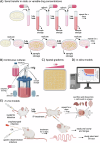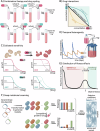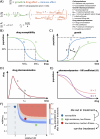Unlocking the potential of experimental evolution to study drug resistance in pathogenic fungi
- PMID: 39843963
- PMCID: PMC11721431
- DOI: 10.1038/s44259-024-00064-1
Unlocking the potential of experimental evolution to study drug resistance in pathogenic fungi
Abstract
Exploring the dynamics and molecular mechanisms of antimicrobial drug resistance provides critical insights for developing effective strategies to combat it. This review highlights the potential of experimental evolution methods to study resistance in pathogenic fungi, drawing on insights from bacteriology and innovative approaches in mycology. We emphasize the versatility of experimental evolution in replicating clinical and environmental scenarios and propose that incorporating evolutionary modelling can enhance our understanding of antifungal resistance evolution. We advocate for a broader application of experimental evolution in medical mycology to improve our still limited understanding of drug resistance in fungi.
© 2024. The Author(s).
Conflict of interest statement
Competing interests: The authors declare no competing interests.
Figures




Similar articles
-
Fungal Drug Response and Antimicrobial Resistance.J Fungi (Basel). 2023 May 12;9(5):565. doi: 10.3390/jof9050565. J Fungi (Basel). 2023. PMID: 37233275 Free PMC article. Review.
-
Antifungal drug resistance: evolution, mechanisms and impact.Curr Opin Microbiol. 2018 Oct;45:70-76. doi: 10.1016/j.mib.2018.02.005. Epub 2018 Mar 13. Curr Opin Microbiol. 2018. PMID: 29547801 Free PMC article. Review.
-
Antimicrobial resistance in the wild: Insights from epigenetics.Evol Appl. 2024 May 29;17(6):e13707. doi: 10.1111/eva.13707. eCollection 2024 Jun. Evol Appl. 2024. PMID: 38817397 Free PMC article. Review.
-
Unlocking Nitrofurantoin: Understanding Molecular Mechanisms of Action and Resistance in Enterobacterales.Med Princ Pract. 2025;34(2):121-137. doi: 10.1159/000542330. Epub 2024 Oct 29. Med Princ Pract. 2025. PMID: 39471786 Free PMC article. Review.
-
Novel Strategies to Combat the Emerging Drug Resistance in Human Pathogenic Microbes.Curr Drug Targets. 2021;22(12):1424-1436. doi: 10.2174/1389450121666201228123212. Curr Drug Targets. 2021. PMID: 33371847 Review.
Cited by
-
Machine learning identifies novel signatures of antifungal drug resistance in Saccharomycotina yeasts.bioRxiv [Preprint]. 2025 May 10:2025.05.09.653161. doi: 10.1101/2025.05.09.653161. bioRxiv. 2025. PMID: 40654776 Free PMC article. Preprint.
-
Genomics insights of candidiasis: mechanisms of pathogenicity and drug resistance.Front Microbiol. 2025 Feb 27;16:1531543. doi: 10.3389/fmicb.2025.1531543. eCollection 2025. Front Microbiol. 2025. PMID: 40083780 Free PMC article. Review.
References
-
- Fisher, K. J. & Lang, G. I. Experimental evolution in fungi: An untapped resource. Fungal Genet. Biol.94, 88–94 (2016). - PubMed
-
- Gerstein, A. C. & Sethi, P. Experimental evolution of drug resistance in human fungal pathogens. Curr. Opin. Genet. Dev.76, 101965 (2022). - PubMed
-
- Furusawa, C., Horinouchi, T. & Maeda, T. Toward prediction and control of antibiotic-resistance evolution. Curr. Opin. Biotechnol.54, 45–49 (2018). - PubMed
-
- Fisher, M. C., Hawkins, N. J., Sanglard, D. & Gurr, S. J. Worldwide emergence of resistance to antifungal drugs challenges human health and food security. Science360, 739–742 (2018). - PubMed
Publication types
LinkOut - more resources
Full Text Sources

